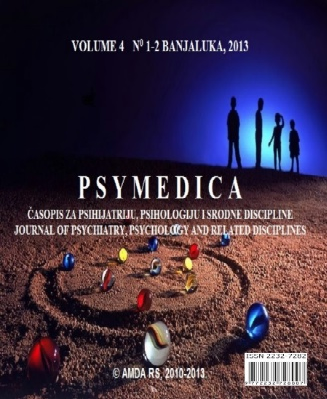IMORTANCE OF MENTAL DISORDERS IN VICTIMIZATION
DOI:
https://doi.org/10.7251/PSY1302015NAbstract
AIM: The aim of this study was to show the importance of mental disorders in victimologic
analysis of socio-demographic and psychopathologic characteristics among victims of the
sexual violence in Bosnia and Herzegovina (B&H) in the post-war period from January 1st
2003. to December 31st 2012.
METHODS: Our hypothesis on involvement of mental disorders in victimization was tested
on a sample of 150 non-violent female victims with mental and behaviour disorders. The
control group consists of 150 victims of violent victimization. The study has been designed as
multicentric, retrospective form of a matched case-controlled study 1:1, it was statistically
processed through multivariate analyses.
RESULTS: In a regressive analysis, violent persons were separated from the non-violent ones
by these redicting predictive factors: age (R = 0.731, df = 2, χ2 = 3.341, P = 0.006, OR =
0.520 (95%), CI = 0.820-0.950), father's education, mother's education, house, mother's
prostitution, PAS in family, sexual abuse and desire for victimization. Members of the control
group had more often lived as lodgers (R = 0.015, χ2 = 4.431, P = 0.007, OR = 0.203, CI =
0.390-0.492), with alcohol abuse and high rate of the family violence, nicotinism and sexual
abuse. Psychological predictive factors in dividing non-violent from violent victims are:
psychoticism (R = 0.791, χ2 = 4.783 df = 1, P < 0.001, OR = 0.749, (95%) CI = 0.368-0,936),
HDRS - total: (R = 1.174, χ2 =10.341, df = 1, P < 0.001, OR = 0.770 (95%) CI = 0.650-
0.910), incorporation, orientation, depressiveness and destructiveness with significance of P =
0.001 in Plutchi's test.
CONCLUSION: Sexual violence among mentally disordered persons makes 20.50% of all
victimizations which were committed by patients with personality disorders and neurotic
persons. It has been demonstrated that females in B&H were more exposed to sexual violence
because of poor mental health protection and increased violence in the family.
Transgenerational model of the stress transmission, victimization in microsocial model of
violence.

